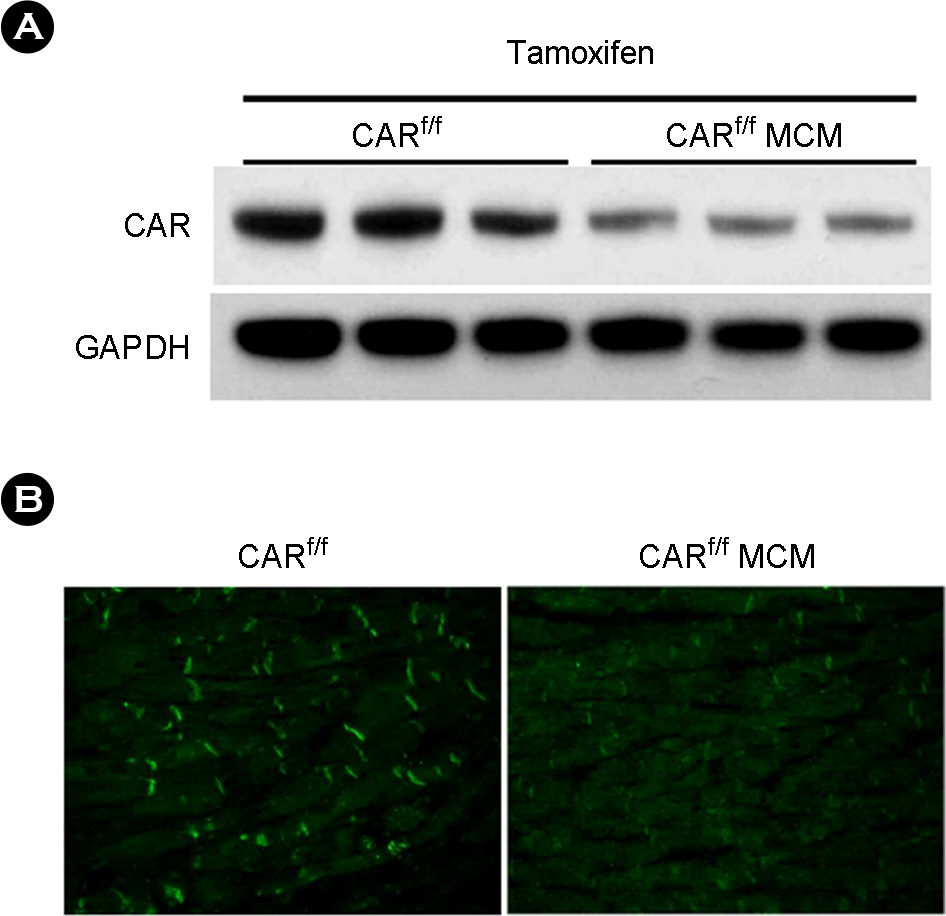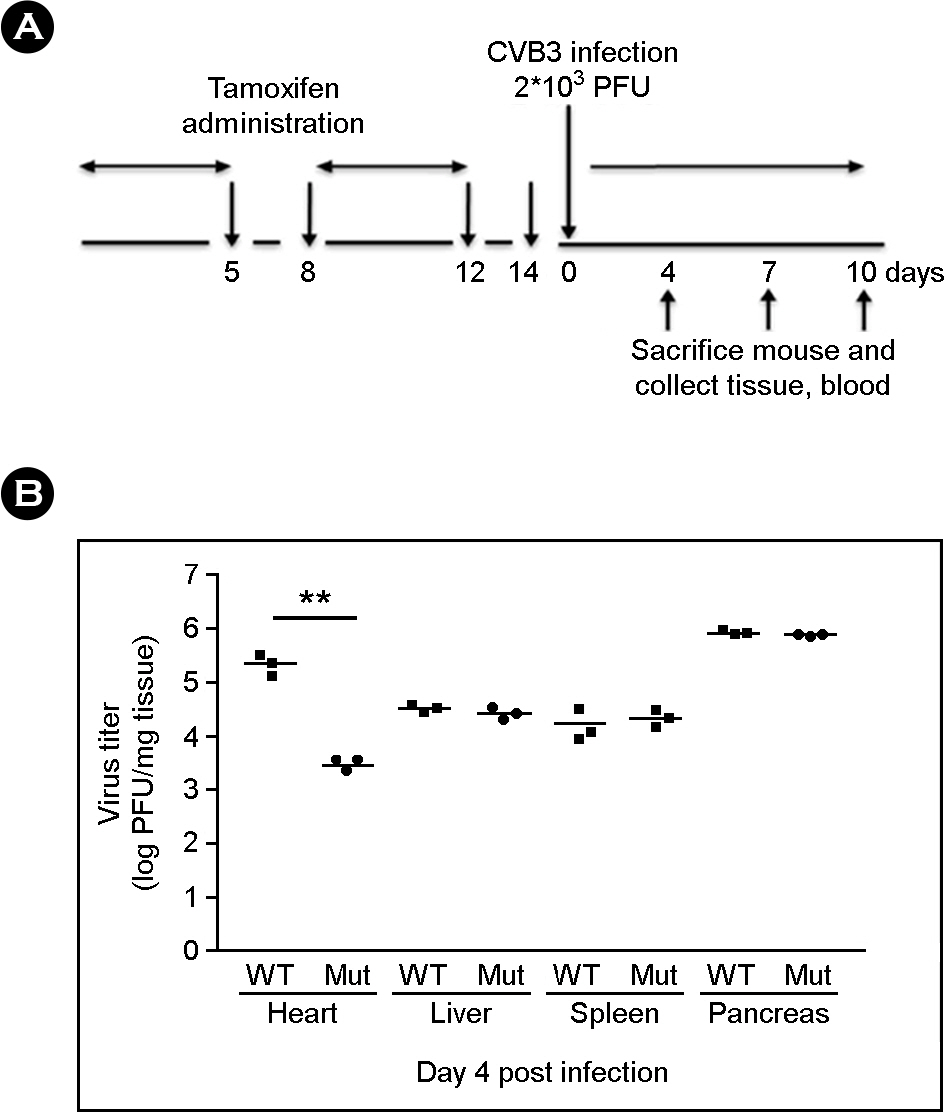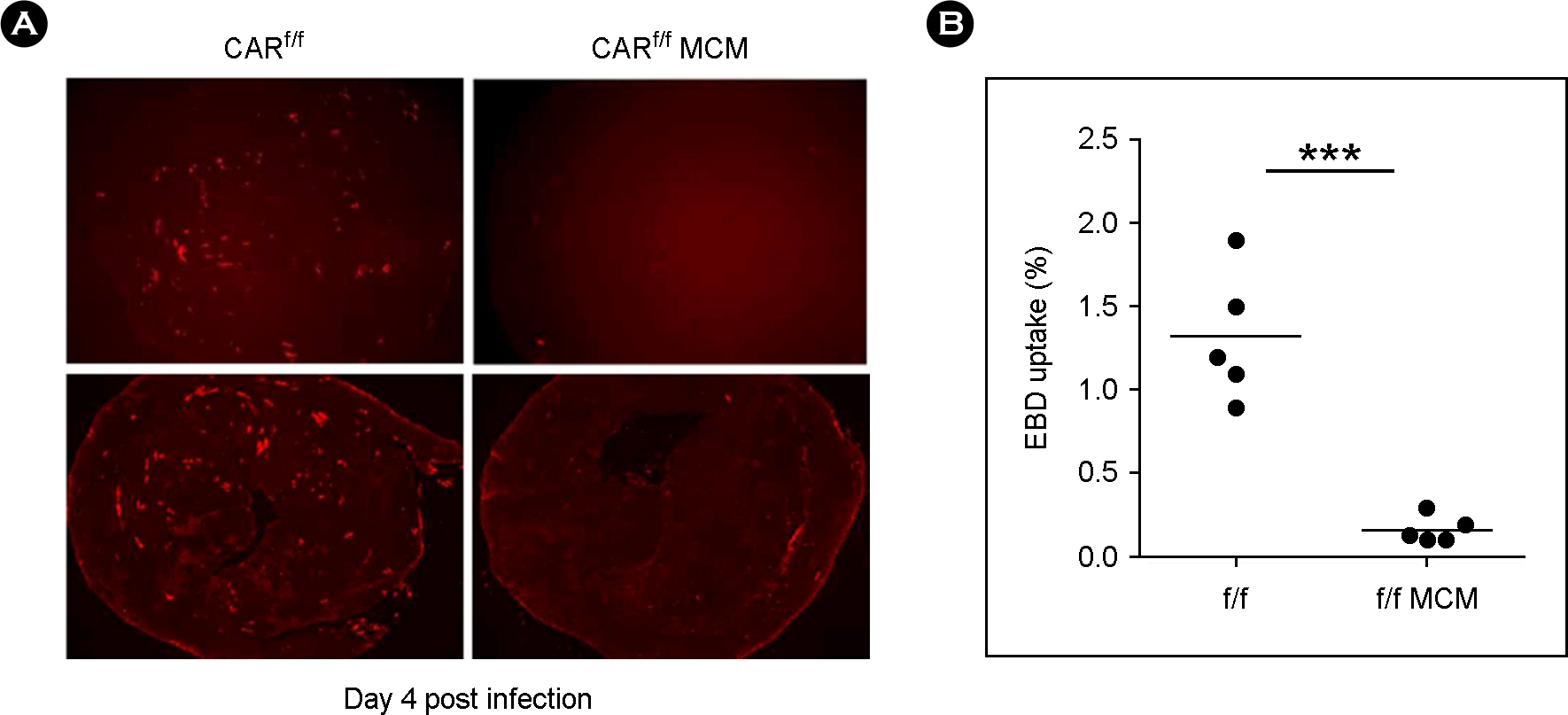J Bacteriol Virol.
2013 Sep;43(3):210-216. 10.4167/jbv.2013.43.3.210.
Cardiac-specific Coxsackievirus and Adenovirus Receptor (CAR) Deletion Inhibit Enterovirus Infection in Murine Heart
- Affiliations
-
- 1Department of Biomedical Science, Jungwon University, Goesan-gun, Chungbuk, Korea. bklim@jwu.ac.kr
- 2Department of Herber Skin Care, College of Herbal Bio-industry, Gyeongsan-si, Gyeongsangbuk-do, Korea.
- KMID: 2286275
- DOI: http://doi.org/10.4167/jbv.2013.43.3.210
Abstract
- The structure of coxsackievirus and adenovirus receptor's CAR is similar to adhesion molecules. In the adult heart, the majority of CAR localizes at the intercalated disc. Germ line CAR deletion induces embryonic lethality at E11.5 with evidence of a cardiac abnormality. The CAR role as a viral receptor is well known; however, its precise function in the heart for enterovirus infection is not clear. To understand the role of CAR in the cardiac myocyte, we generated cardiac-specific CAR knockout mice using a CAR floxed allele and alpha-MHC-Mer CRE Mer mice. Western blot analysis and immunofluorescent stain of ventricles at 6 weeks after 2 weeks tamoxifen administration, CAR expression was significantly decreased in CAR(f/f) MCM mice but not in CAR(f/f) mice heart. Enterovirus was intraperitoneally infected into CAR(f/f) MCM and CAR(f/f) mice (n=10 each). CAR disruption was dramatically reduced virus infection and replication in the heart but not different in liver, spleen, and pancreas. Cardiac myocyte damage was significantly reduced in the CAR(f/f) MCM mutant mice by evans blue dye stain. In addition, the CAR(f/f) MCM mutant mice heart inflammation and fibrosis were decreased in H&E and trichrome stain compare to CAR(f/f) control mice. CAR expression was required for normal ventricular function, but it is the cause of enterovirus infection. In the adult mice heart, CAR deletion was significantly reduced viral infection, proliferation, and myocarditis. These results suggested that CAR deletion could be useful therapeutic strategy to prevent viral myocarditis.
Keyword
MeSH Terms
-
Adenoviridae
Adult
Alleles
Animals
Azo Compounds
Blotting, Western
Enterovirus
Enterovirus Infections
Eosine Yellowish-(YS)
Evans Blue
Fibrosis
Germ Cells
Heart
Humans
Inflammation
Liver
Methyl Green
Mice
Mice, Knockout
Myocarditis
Myocytes, Cardiac
Pancreas
Receptors, Virus
Spleen
Tamoxifen
Ventricular Function
Viruses
Azo Compounds
Eosine Yellowish-(YS)
Evans Blue
Methyl Green
Receptors, Virus
Tamoxifen
Figure
Reference
-
1). Bergelson JM, Cunningham JA, Droguett G, Kurt-Jones EA, Krithivas A, Hong JS, et al. Isolation of a common receptor for Coxsackie B viruses and adenoviruses 2 and 5. Science. 1997; 275:1320–3.
Article2). Lim BK, Xiong D, Dorner A, Youn TJ, Yung A, Liu TI, et al. Coxsackievirus and adenovirus receptor (CAR) mediates atrioventricular-node function and connexin 45 localization in the murine heart. J Clin Invest. 2008; 118:2758–70.
Article3). Baboonian C, Davies MJ, Booth JC, McKenna WJ. Coxsackie B viruses and human heart disease. Curr Top Microbiol Immunol. 1997; 223:31–52.
Article4). Lim BK, Choi JH, Nam JH, Gil CO, Shin JO, Yun SH, et al. Virus receptor trap neutralizes coxsackievirus in experimental murine viral myocarditis. Cardiovasc Res. 2006; 71:517–26.
Article5). Coyne CB, Bergelson JM. CAR: a virus receptor within the tight junction. Adv Drug Deliv Rev. 2005; 57:869–82.
Article6). Noutsias M, Fechner H, de Jonge H, Wang X, Dekkers D, Houtsmuller AB, et al. Human coxsackie-adenovirus receptor is colocalized with integrins alpha(v)beta(3) and alpha(v)beta(5) on the cardiomyocyte sarcolemma and upregulated in dilated cardiomyopathy: implications for cardiotropic viral infections. Circulation. 2001; 104:275–80.7). Dorner AA, Wegmann F, Butz S, Wolburg-Buchholz K, Wolburg H, Mack A, et al. Coxsackievirus-adenovirus receptor (CAR) is essential for early embryonic cardiac development. J Cell Sci. 2005; 118:3509–21.
Article8). Asher DR, Cerny AM, Weiler SR, Horner JW, Keeler ML, Neptune MA, et al. Coxsackievirus and adenovirus receptor is essential for cardiomyocyte development. Genesis. 2005; 42:77–85.
Article9). Kumai M, Nishii K, Nakamura K, Takeda N, Suzuki M, Shibata Y. Loss of connexin45 causes a cushion defect in early cardiogenesis. Development. 2000; 127:3501–12.
Article10). Egashira K, Nishii K, Nakamura K, Kumai M, Morimoto S, Shibata Y. Conduction abnormality in gap junction protein connexin45-deficient embryonic stem cell-derived cardiac myocytes. Anat Rec A Discov Mol Cell Evol Biol. 2004; 280:973–9.
Article11). Coppen SR, Kodama I, Boyett MR, Dobrzynski H, Takagishi Y, Honjo H, et al. Connexin45, a major connexin of the rabbit sinoatrial node, is co-expressed with connexin43 in a restricted zone at the nodal-crista terminalis border. J Histochem Cytochem. 1999; 47:907–18.
Article12). Excoffon KJ, Hruska-Hageman A, Klotz M, Traver GL, Zabner J. A role for the PDZ-binding domain of the coxsackie B virus and adenovirus receptor (CAR) in cell adhesion and growth. J Cell Sci. 2004; 117:4401–9.
Article13). Lisewski U, Shi Y, Wrackmeyer U, Fischer R, Chen C, Schirdewan A, et al. The tight junction protein CAR regulates cardiac conduction and cell-cell communication. J Exp Med. 2008; 205:2369–79.
Article14). Feldman AM, McNamara D. Myocarditis. N Engl J Med. 2000; 343:1388–98.
Article15). Knowlton KU, Jeon ES, Berkley N, Wessely R, Huber S. A mutation in the puff region of VP2 attenuates the myocarditic phenotype of an infectious cDNA of the Woodruff variant of coxsackievirus B3. J Virol. 1996; 70:7811–8.
Article16). Liu P, Martino T, Opavsky MA, Penninger J. Viral myocarditis: balance between viral infection and immune response. Can J Cardiol. 1996; 12:935–43.17). Lim BK, Choe SC, Shin JO, Ho SH, Kim JM, Yu SS, et al. Local expression of interleukin-1 receptor antagonist by plasmid DNA improves mortality and decreases myocardial inflammation in experimental coxsackieviral myocarditis. Circulation. 2002; 105:1278–81.
Article18). He Y, Chipman PR, Howitt J, Bator CM, Whitt MA, Baker TS, et al. Interaction of coxsackievirus B3 with the full length coxsackievirus-adenovirus receptor. Nat Struct Biol. 2001; 8:874–8.19). Xiong D, Yajima T, Lim BK, Stenbit A, Dublin A, Dalton ND, et al. Inducible cardiac-restricted expression of enteroviral protease 2A is sufficient to induce dilated cardiomyopathy. Circulation. 2007; 115:94–102.
Article20). Yun SH, Lee WG, Kim YC, Ju ES, Lim BK, Choi JO, et al. Antiviral activity of coxsackievirus B3 3C protease inhibitor in experimental murine myocarditis. J Infect Dis. 2012; 205:491–7.
Article
- Full Text Links
- Actions
-
Cited
- CITED
-
- Close
- Share
- Similar articles
-
- Detection and Phylogenetic Analysis of Coxsackievirus A24 Variant Causing Nation-wide Epidemic of Acute Hemorrhagic Conjunctivitis in Korea, 2002
- Enterovirus 71 infection and vaccines
- Detection and Characterization of Enteroviral RNA in Paraffin-embedded Heart Tissues form Patients with Dilated Cardiomyopathy
- Uncleaved Dystrophin Induce Cardiac Myocyte Apoptosis in Coxsackievirus Infected Balb/C Background Mice Heart
- Enhancement of Transduction Efficiency and Antitumor Effects of IL-12N220L-expressing Adenovirus by Co-delivery of DOTAP





